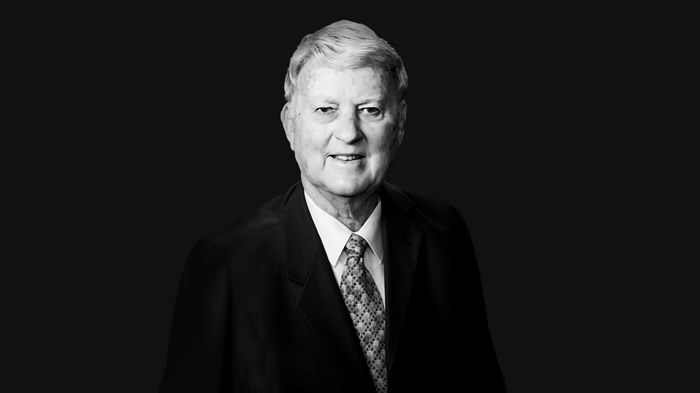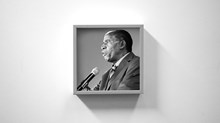
Vinson Synan, one of the first historians of Pentecostalism and a powerful advocate for the breadth and depth of the Pentecostal movement, died on Sunday. He was 85.
Synan was a professionally trained historian with a doctorate from the University of Georgia. He was the son of a Pentecostal pastor who himself became a Pentecostal pastor and eventually the assistant general superintendent of the International Pentecostal Holiness Church (IPHC).
He sometimes experienced a “tug of war” between his scholarly and religious commitments, Synan wrote in his 2010 memoir. But in both roles, he helped people understand Pentecostalism as a tradition with deep Protestant roots and as an ongoing movement that was expanding to include Christians in all denominations all over the world.
Born in 1934 and raised in the Pentecostal Holiness church, some of Synan’s earliest memories were listening to his father and uncle preach to poor white people during the Great Depression in small Virginia churches and revivals.
“People would be up on their feet ‘shouting the victory,’” he wrote. “The altar calls were a sight to behold and sometimes painful to hear. People crowded the front of the church seeking salvation, sanctification, baptism in the Holy Spirit, or divine healing. Often the roar of concert prayer was deafening.”
These people were known derogatively as “holy rollers.” Synan found the term offensive and grew interested in the history of Pentecostalism. He was surprised to find that the elders in his church knew little of their Pentecostal past.
His father, Joseph Synan, didn’t know anything about Charles Fox Parham, for example, the original proponent of the decisive Pentecostal doctrine that speaking in tongues is “Bible evidence” of a second baptism and the indwelling of the Holy Spirit.
The elder Synan did know about the second leader of the movement, William J. Seymour, who led the Azusa Street Revival in Los Angeles in 1906, but he didn’t have all the details right. He told his son that Seymour, an African American, was “a one-legged man.” Seymour actually had two good legs but was blind in one eye from smallpox. In the tangle of testimonies of faith and miracles, passed down from preacher to son, the bad eye had somehow become a missing leg.
But 12-year-old Vinson Synan was awestruck. The misremembered and half-remembered history fascinated him. He had to know the true scale and scope of the Pentecostal tradition.
That became possible at the University of Georgia, where the historian Horace Montgomery allowed Synan to write his dissertation on the history of the movement. Pentecostalism was an unusual subject for an academic study, but Montgomery—a Unitarian Universalist who studied the politics of poor white people—thought it was interesting, and he promoted the project. It became Synan’s groundbreaking 1971 history, The Holiness-Pentecostal Movement.
The book rooted Pentecostalism in the teachings of John Wesley, arguing it didn’t spring from nothing but developed out of British and American revivalism, Anglican spirituality, and the Keswick “higher living” theology. Synan’s account has become the standard narrative of Pentecostalism, but at the time it cut against Pentecostals’ sense of themselves as a Holy Spirit rupture in history.
When Synan published a revised version of the book in 1997, he changed the title to The Holiness-Pentecostal Tradition. He was arguing, he said, that Pentecostalism was a tradition, “despite the fact that most Pentecostals have disdained the word ‘tradition’ as belonging to the older and colder ‘established’ churches.”
In the process of researching and publishing the book, Synan also met and befriended the archivists and church historians at the different Pentecostal denominations. He brought them together in 1970 to start the Society for Pentecostal Studies, the first academic guild for the purpose.
Synan was not interested in a purely academic relationship to Pentecostalism, though. Even as he was working on his dissertation, he planted and pastored a Pentecostal church in Georgia. And as a minister, he found his own sense of Pentecostalism expanding in the 1970s.
He was invited to a prayer breakfast, hosted by the Full Gospel Business Men’s Fellowship International, and was surprised to find non-Pentecostals there—praying in tongues. Synan saw a Lutheran minister praying to be filled with the Spirit. Synan’s first instinct, he recalled in his memoir, was to criticize the man for doing it wrong. He was sitting down, when he should be standing up. He was definitely praying too quietly. Then the minister started speaking a language that sounded like Arabic, a language he didn’t know. Synan understood it to be a gift from God and a rebuke to his own small faith.
Next Synan read about the “Jesus People,” hippies who loved Jesus and were filled with the Spirit in California. He was shocked, but thrilled, to find those people could be Pentecostal too.
Then Synan witnessed the Catholic Charismatic Renewal as it broke out at the University of Notre Dame. He was stunned. It was, he would later write, the most surprising turn in the whole history of Pentecostalism. “That came as an utter shock to me,” he said, “to most of my friends, and probably to the Catholic Church.”
For the rest of his life, Synan advocated for a broader understanding of the Pentecostal movement and helped lead an ecumenical Charismatic movement, including organizing and chairing gatherings of the North American General Congress on the Holy Spirit and World Evangelization. He also became general secretary, assistant to the general superintendent, and director of evangelicalism for the IPHC.
“No one in our movement has been more influential in global Christianity than him,” said Doug Beacham, general superintendent of the IPHC. “He was a pillar in the mid-20th century move of the Holy Spirit that impacted Christians from nearly every faith family within Protestantism and Catholicism. We are grateful for his scholarship, his passion for Jesus Christ, his love and service to the IPHC, and for the way he and his wife Carol and their children consistently demonstrated what it means to live in the Holy Spirit.”
As an academic, Synan served as director of the Holy Spirit Research Center at Oral Roberts University and dean of the School of Divinity at Regent University, while writing extensively on the history of Pentecostalism. His scholarship served as the starting place for generations of historians. Synan was also active observing and explaining contemporary developments—from the scandals of televangelists to new revivals, like the Brownsville revival in Pensacola, Florida—and predicting Pentecostalism’s future.
Going forward, he told CT in 2010, Pentecostalism would likely become more diverse and more global, growing in Asia, Latin America, and Africa. And it would face some challenges.
The biggest, he said, would be to “keep the Pentecostal fire burning. All of its big revivals have cooled off after a generation or so. Pentecostalism is into its second century, but it’s still vigorous because it tends to renew itself every 30 or 40 years. If [its leaders] keep the excitement and the fire going intellectually and culturally, the [movement will] continue to grow.”
Synan is survived by his wife and four children. He will be buried in Chester, Virginia.
CT also recently covered the death of fellow Pentecostal historian Edith Blumhofer, of Wheaton College, who passed away March 5.

Support Our Work
Subscribe to CT for less than $4.25/month


















